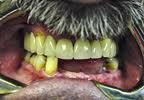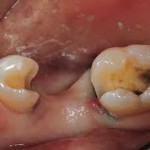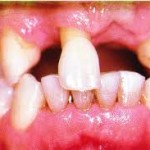Criteria 4: Residual Ridge Characteristics
The criteria published for the Classification System for Complete Edentulism are used to categorize any edentulous span present in the partially edentulous patient.
The 4 criteria and their subclassifications are organized into an overall classification system for partial edentulism.
Class I
This class is characterized by ideal or minimal compromise in the location and extent of edentulous area (which is confined to a single arch), abutment conditions, occlusal characteristics, and residual ridge conditions. All 4 of the diagnostic criteria are favorable.
1. The location and extent of the edentulous area are ideal or minimally compromised:
â— The edentulous area is confined to a single arch.
â— The edentulous area does not compromise the physiologic support of the abutments.
â— The edentulous area may include any anterior maxillary span that does not exceed 2 incisors, any anterior mandibular span that does not exceed 4 missing incisors, or any posterior span that does not exceed 2 premolars or 1 premolar and 1 molar.
2. The abutment condition is ideal or minimally compromised, with no need for preprosthetic therapy.
3. The occlusion is ideal or minimally compromised, with no need for preprosthetic therapy; maxillomandibular relationship: Class I molar and jaw relationships.
4. Residual ridge morphology conforms to the Class I complete edentulism description.
Class II
This class is characterized by moderately compromised location and extent of edentulous areas in both arches, abutment conditions requiring localized adjunctive therapy, occlusal characteristics requiring localized adjunctive therapy, and residual ridge conditions.
1. The location and extent of the edentulous area are moderately compromised:
â— Edentulous areas may exist in 1 or both arches.
â— The edentulous areas do not compromise the physiologic support of the abutments.
â— Edentulous areas may include any anterior maxillary span that does not exceed 2 incisors, any anterior mandibular span that does not exceed 4 incisors, any posterior span (maxillary or mandibular) that does not exceed 2 premolars, or 1 premolar and 1 molar or any missing canine (maxillary or mandibular).
2. Condition of the abutments is moderately compromised:
â— Abutments in 1 or 2 sextants have insufficient tooth structure to retain or support intracoronal or extracoronal restorations.
â— Abutments in 1 or 2 sextants require localized adjunctive therapy.
3. Occlusion is moderately compromised:
â— Occlusal correction requires localized adjunctive therapy.
â— Maxillomandibular relationship: Class I molar and jaw relationships.
4. Residual ridge morphology conforms to the Class II complete edentulism description.
Class III
This class is characterized by substantially compromised location and extent of edentulous areas in both arches, abutment condition requiring substantial localized adjunctive therapy, occlusal characteristics requiring reestablishment of the entire occlusion without a change in the occlusal vertical dimension, and residual ridge condition.
1. The location and extent of the edentulous areas are substantially compromised:
â— Edentulous areas may be present in 1 or both arches.
â— Edentulous areas compromise the physiologic support of the abutments.
â— Edentulous areas may include any posterior maxillary or mandibular edentulous area greater than 3 teeth or 2 molars, or anterior and posterior edentulous areas of 3 or more teeth.
2. The condition of the abutments is moderately compromised:
â— Abutments in 3 sextants have insufficient tooth structure to retain or support intracoronal or extracoronal restorations.
â— Abutments in 3 sextants require more substantial localized adjunctive therapy (ie, periodontal, endodontic or orthodontic procedures).
â— Abutments have a fair prognosis.
3. Occlusion is substantially compromised:
â— Requires reestablishment of the entire occlusal scheme without an accompanying change in the occlusal vertical dimension.
â— Maxillomandibular relationship: Class II molar and jaw relationships.
4. Residual ridge morphology conforms to the Class III complete edentulism description.
Class IV
This class is characterized by severely compromised location and extent of edentulous areas with guarded prognosis, abutments requiring extensive therapy, occlusion characteristics requiring reestablishment of the occlusion with a change in the occlusal vertical dimension, and residual ridge conditions.
1. The location and extent of the edentulous areas results in severe occlusal compromise:
â— Edentulous areas may be extensive and may occur in both arches.
â— Edentulous areas compromise the physiologic support of the abutment teeth to create a guarded prognosis.
â— Edentulous areas include acquired or congenital maxillofacial defects.
â— At least 1 edentulous area has a guarded prognosis.
2. Abutments are severely compromised:
â— Abutments in 4 or more sextants have insufficient tooth structure to retain or support intracoronal or extracoronal restorations.
â— Abutments in 4 or more sextants require extensive localized adjunctive therapy.
â— Abutments have a guarded prognosis.
3. Occlusion is severely compromised:
â— Reestablishment of the entire occlusal scheme, including changes in the occlusal vertical dimension, is necessary.
â— Maxillomandibular relationship: class II division 2 or Class III molar and jaw relationships.
4. Residual ridge morphology conforms to the class IV complete edentulism description.
Other characteristics include severe manifestations of local or systemic disease, including sequelae from oncologic treatment, maxillomandibular dyskinesia and/or ataxia, and refractory patient (a patient who presents with chronic complaints following appropriate therapy).
Guidelines for the Use of Classification System for Partial Edentulism
The analysis of diagnostic factors is facilitated with the use of a worksheet. Each criterion is evaluated and a checkmark placed in the appropriate box. In those instances in which a patient’s diagnostic criteria overlap 2 or more classes, the patient is placed in the more complex class. The following additional guidelines should be followed to ensure consistent application of the classification system:
1. Consideration of future treatment procedures must not influence the choice of diagnostic level.
2. Initial preprosthetic treatment and/or adjunctive therapy can change the initial classification level. Classification may need to be reassessed after existing prostheses are removed.
3. Esthetic concerns or challenges raise the classification by 1 level in Class I and II patients.
4. The presence of TMD symptoms raises the classification by 1 or more levels in Class I and II patients.
5. In a patient presenting with an edentulous maxilla opposing a partially edentulous mandible, each arch is diagnosed according to the appropriate classification system; that is, the maxilla is classified according to the complete edentulism classification system, and the mandible is classified according to the partial edentulism classification system. The sole exception to this rule occurs when the patient presents with an edentulous mandible opposed by a partially edentulous or dentate maxilla. This clinical situation presents significant complexity and potential long-term morbidity and as such, should be diagnosed as a Class IV in either system.
6. Periodontal health is intimately related to the diagnosis and prognosis for partially edentulous patients. For the purpose of this system, it is assumed that patients will receive therapy to achieve and maintain periodontal health so that appropriate prosthodontic care can be accomplished.



